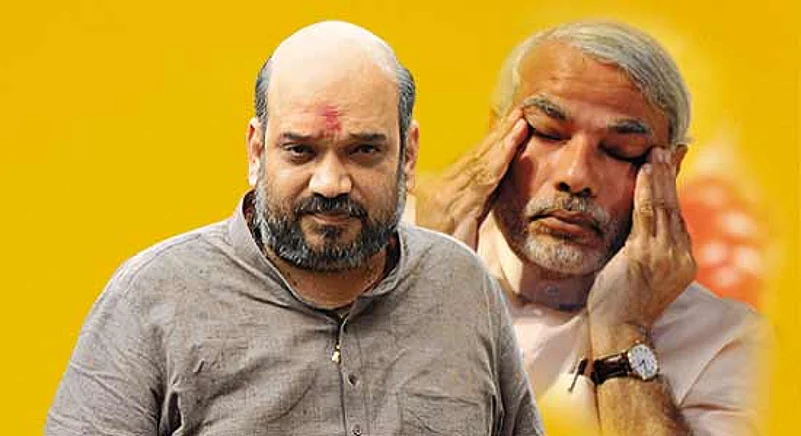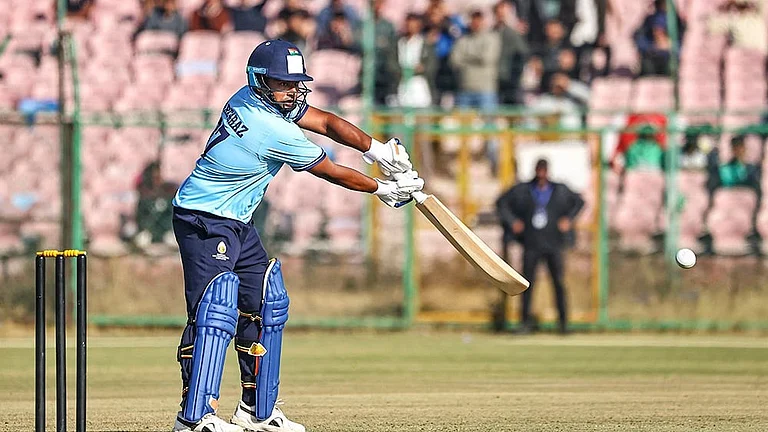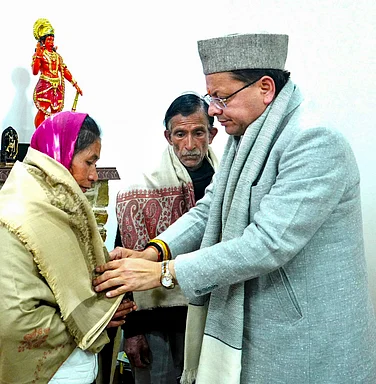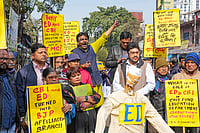“Encounters in Gujarat started taking place after Haren Pandya’s murder. I don’t want to comment on it because it is now the CBI that has to tell us the motive behind his death and subsequent encounters. My individual opinion is not important. Let the BJP and people of Gujarat decide whether they want Amit Shah to campaign in these elections or not.”—Jagruti, wife of slain BJP leader
and former MoS for home Haren Pandya, to Outlook
Narendra Modi is fighting the most high-pitched state battle in recent years, one that has national implications. His right-hand man in earlier contests, the executor par excellence of all his plans in the state, has been Amit Shah. Modi’s minister of state for home from 2003 to 2010, he is said to know every detail of every seat in Gujarat. In 2007, one of the lesser-known stories about the Gujarat assembly polls was the manner in which the RSS/VHP actually employed local strategies to cut Modi down to size. In circles that know, it is said that Amit Shah played a key role in countering all such plans. Put up X as an independent here, pay Y some money to change his mind, give Z a strong arm-twist and so on. Stories about Shah’s virtuosity are part of BJP lore in Gujarat. There is also the anecdote about how he paid a certain member of the minority community to put up dummy candidates to cut into the votes of the Congress minority candidates. He is said to be a man who “can do this and who can also do that!”
Over two years ago, the courts were told he’s also a man who can order murder. On July 23, 2010, Shah was charged in the encounter killing five years earlier of small-time extortionist Sohrabuddin Sheikh and his wife Kauser Bi, for which he had to quit as MoS. He spent three months in Sabarmati jail after which he got bail, but had to spend time hanging around in Delhi because he had been ordered to stay out of the state so as not to influence the cases. Then, just around 10 days ago, on Sep 27, the Supreme Court asked the Sohrabuddin-Kauser Bi case to be shifted to Maharashtra and allowed Shah to return to Gujarat. As is being said in BJP circles, lucky for Modi to have got his man back at a time when he’d need all his possible skills.
But for a man who nurses an ambition to be India’s prime minister, is Amit Shah an asset or eventually a liability? Shah may have been feted at the recent BJP national executive in Surajkund in Haryana, and categorically told Outlook that “Modiji is winning with a two-thirds majority, I’ll campaign for him and, if the party wants, will also contest” (see interview, left), but the encounter cases continue to dog him. In fact, legal and political pundits say that unless a friendly government takes charge in Delhi, Shah will find it hard to escape the legal noose. To make matters worse, just two days after being allowed into Gujarat, on Sep 29, the CBI named him as ‘accused number one’ in the conspiracy to kill Tulsiram Prajapati near Palanpur (Gujarat) on Dec 28, 2006. Prajapati was killed by cops as he could have been a witness in the Sohrabuddin-Kauser Bi murder. Shah’s name tops the list of 19 other accused in the CBI chargesheet filed in a special court.
Those who follow the legal cases in Gujarat say that while it has been difficult to pin down Modi in the 2002 riots cases, the law could well catch up with Modi in the encounter cases through his indispensable deputy. With several cases in Gujarat now being determined to be fake encounters, the narrative that emerges is as follows: after the thumping win in the 2002 state election, a series of ‘executions’ began from 2003 onwards, in which the FIRs almost always read that persons (all Muslims) were killed by the police as they had come to execute the chief minister. This, Ahmedabad-based lawyer Mukul Sinha contends, happened under the instruction of a regime trying to perpetuate the stereotype of the Muslim terrorist out to assassinate the Hindu hero. Shah himself in his interview to Outlook says, “What do you think people like Sohrabuddin were?... Those who died in encounters in Gujarat were not even anti-social elements; they were all anti-nationals.”
The script for Shah and his policemen friends, however, began to unravel after Sohrabuddin’s brother Rubabuddin approached the Supreme Court in 2007, and the inquiries that followed in 2010 exposed a shocking narrative that landed many policemen in jail. Following this, earlier encounters too were probed and declared to be fake. Question marks still hang over the 2004 killing of Mumbai student Ishrat Jahan. Sources say there may be more to come as 15 other encounters are under investigation. Another cause for worry for the Modi regime is that about 20 policemen, some from the ips, are in jail. Says an officer: “There is mounting anger that the politicians who ordered all this are getting away while the men who only executed orders are in jail.” In the latest Prajapati chargesheet, six more officers are implicated.
The CBI chargesheet, in fact, lays out in precise detail how there was a sudden spike in the number of phone calls between Shah and Gujarat police officers D.G. Vanzara and S. Rajkumar Pandian and Udaipur SP Dinesh M.N. (all now in jail) each time Prajapati moved or made a court appearance. Like when he was produced at Metropolitan Magistrate Court No. 13 in Ahmedabad on Nov 14, 2006, or when he was transported from Udaipur to Gujarat. All this in the days preceding the final killing.
Shah is accused of doing everything possible in his power to manipulate the investigation and destroy evidence that could put his trusted officers in trouble in the Sohrabuddin-Kauser Bi killing. This, as the charge goes, included getting Prajapati killed. The CBI chargesheet claims that Shah, at some point between Dec 12-21, 2006, called DGP P.C. Pande, IGP (CID) Geetha Johri, both also accused in the chargesheet, and ADGP CID (crime) G.C. Raigar to his office and “expressed his displeasure about the ongoing (and damaging) inquiry being carried out by V.L. Solanki (an inspector-rank officer in the CID)”. “He (Shah) further expressed his annoyance about how an officer of the rank of an inspector could dare to write a report which could land senior officers like D.G. Vanzara and S. Rajkumar Pandian in trouble.”

Shah gets drawn further into the plot. According to the document, he asked Johri to destroy the inquiry papers submitted by Solanki. While Raigar backed out of this demand, Pande and Johri were “willing collusive members of these conspiratorial instructions”. The then MoS for home is accused of coopting Pande, using the “enormous power of his political patronage”, to delay lawful investigation. Pande sat on Solanki’s interim report on the Sohrabuddin-Kauser Bi case dated Sep 1, 2006, and turned it in to the SC only on Dec 7, over a year after their deaths and a few days before Prajapati’s murder. He also let the preliminary inquiry drag on for nine months until it was handed over to the CID in March 2007. This delay, the chargesheet points out, helped in the planning and execution of Prajapati’s murder, who could otherwise have testified against the accused.
In return for his services, the chargesheet points out, Pande became the first retired ips officer to be appointed as the chairman of the Gujarat State Police Housing Corporation. Raigar, on the other hand, paid for not complying with Shah’s orders, and was removed as the head of CID and replaced with O.P. Mathur, another accused in the chargesheet.
Vanzara and other police officers may have thought they could easily do away with a small-timer like Sohrabuddin. To do so, the chargesheet maintains, Vanzara and then SP Valsad Abhay Chudasama urged fellow criminal Prajapati to help them trace Sohrabuddin. Prajapati agreed after the two assured him and Sohrabuddin of a safe passage. Accordingly, he informed the duo of Sohrabuddin’s plan to travel to Sangli in Maharashtra from Hyderabad. A Gujarat police team led by ATS SP Rajkumar Pandian reached Hyderabad and trailed the bus (KA-05-AF-5051) Sohrabuddin, Kauser Bi and Prajapati were travelling on. When the bus reached Tandola village in Karnataka, the three were made to deboard on the intervening night on Nov 22-23. They were then brought to Valsad in Gujarat, from where Prajapati was allowed to return to Bhilwara in Rajasthan.
He was, however, murdered a year later, when he started fearing he too would be killed like Sohrabuddin, and started making noises and writing to authorities like the National Human Rights Commission. He was picked up from Bhilwara under the orders of Udaipur SP Dinesh M.N., who is also alleged to be involved in the murder of Sohrabuddin, and later brought to Udaipur—to keep him under control. When Vanzara interrogated him, Prajapati asked him why Sohrabuddin and his wife had been killed. Vanzara threatened him and said he’d meet the same fate if he didn’t shut up. It was after this that Prajapati, who had been sent back to Udaipur jail, started telling visiting family and friends of his role in helping locate Sohrabuddin and the threat to his own life. He even sent a letter saying the same to the NHRC, claiming the Gujarat police had similarly killed many criminals in the past. To silence him, it was made to seem that Prajapati was killed while trying to escape as he was being escorted on a train to Udaipur. However, according to the chargesheet, he was actually taken to the crime scene and shot in cold blood by sub-inspector Aashish Pandya.
In Delhi, CBI sources say, the case against Shah is strong. Another Modi aide, former minister Maya Kodnani, was convicted recently in the Naroda Patiya case, again on the basis of similar records. Says Justice Hosbet Suresh, who was part of a fact-finding committee on the Gujarat cases, “Amit Shah has been nailed by the agency. However, a little further investigation would have helped bring out the name of the chief conspirators who would be the top leadership in this case.” That may not happen, but Modi must certainly ask himself whether it’s prudent for a man claiming to do great things and aspiring to a great office to hang around with one accused of having ordered murder.
***
How The CBI Chargesheet Nails Amit Shah
Some of the damning allegations against the former MoS for home
- Prajapati, the Informer Gujarat police asks ‘small-time criminal’ Tulsiram Prajapati to help trace alleged extortionist Sohrabuddin. Prajapati discloses Sohrabuddin’s travel plans and is with him and his wife till the police takes them away and kills them. His testimony could have exposed the fake killing.
- Call Centre There’s a sudden spike in calls between Amit Shah and accused police officers D.G. Vanzara and S. Rajkumar Pandian each time there’s a development related to Prajapati, who’s under custody. Like on Nov 14, 2006, when Prajapati’s produced at Metropolitan Magistrate Court No. 13 in Ahmedabad.
- Master of Manoeuvre The CBI chargesheet alleges that Amit Shah used his power as Gujarat MoS for home to force police officers to either delay investigations, or manipulate them in his own favour or that of his trusted sherpas like Vanzara and Rajkumar. Those who complied were rewarded; others penalised.
- The Solanki Headache So, when CID inspector V.L. Solanki turns in a report that establishes Sohrabuddin and his wife being whisked away from Tandola village in Karnataka and killed in a fake encounter, this gets Shah worried. He calls an urgent meeting to “express his displeasure” and set things right.
- The Bumping Off Shah even asks Solanki’s boss, IG, CID, Geetha Johri, to destroy the inquiry papers. She complies, destroying even a written request from Solanki to travel to Udaipur to question Prajapati. Permission delayed, he doesn’t get the chance as Prajapati is shot point-blank by SI Aashish Pandya.
By Saba Naqvi and Debarshi Dasgupta with Chandrani Banerjee & Panini Anand


























